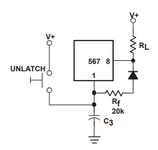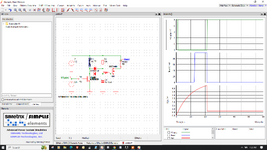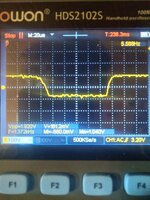Paul_V
Newbie level 4

Hello, everyone.
I'm designing a circuit with several LM567 IC's.
It's open-collector output should trigger a logic gate latch and open a lock, once desired frequency is detected.
Using the reference schematic, IC works as expected, turning LED on, when input frequency match.
However, when I power-up the circuit, I'm constantly getting a false trigger. LED turns on momentarily.
This is a problem in my design, because it also triggers the latch during power-up, opening a lock.
Tried adding RC, additional pull-up resistor, darlington, input filtering, soft start, etc.
RC does help, but only for a couple of short power-ups and reduces overall sensitivity of the circuit.
What puzzles me even more, there is a schematic in the datasheet to convert LM567 output to behave as a latch, which also false triggers on power-up.
How can I prevent this power-up trigger?
Thanks a lot in advance.

I'm designing a circuit with several LM567 IC's.
It's open-collector output should trigger a logic gate latch and open a lock, once desired frequency is detected.
Using the reference schematic, IC works as expected, turning LED on, when input frequency match.
However, when I power-up the circuit, I'm constantly getting a false trigger. LED turns on momentarily.
This is a problem in my design, because it also triggers the latch during power-up, opening a lock.
Tried adding RC, additional pull-up resistor, darlington, input filtering, soft start, etc.
RC does help, but only for a couple of short power-ups and reduces overall sensitivity of the circuit.
What puzzles me even more, there is a schematic in the datasheet to convert LM567 output to behave as a latch, which also false triggers on power-up.
How can I prevent this power-up trigger?
Thanks a lot in advance.




